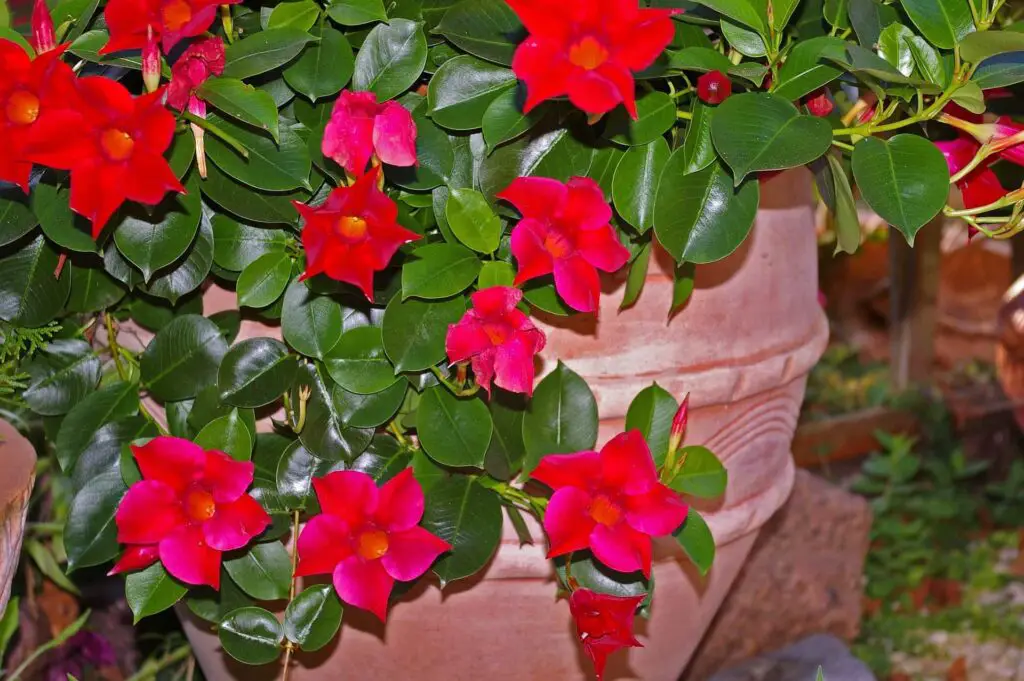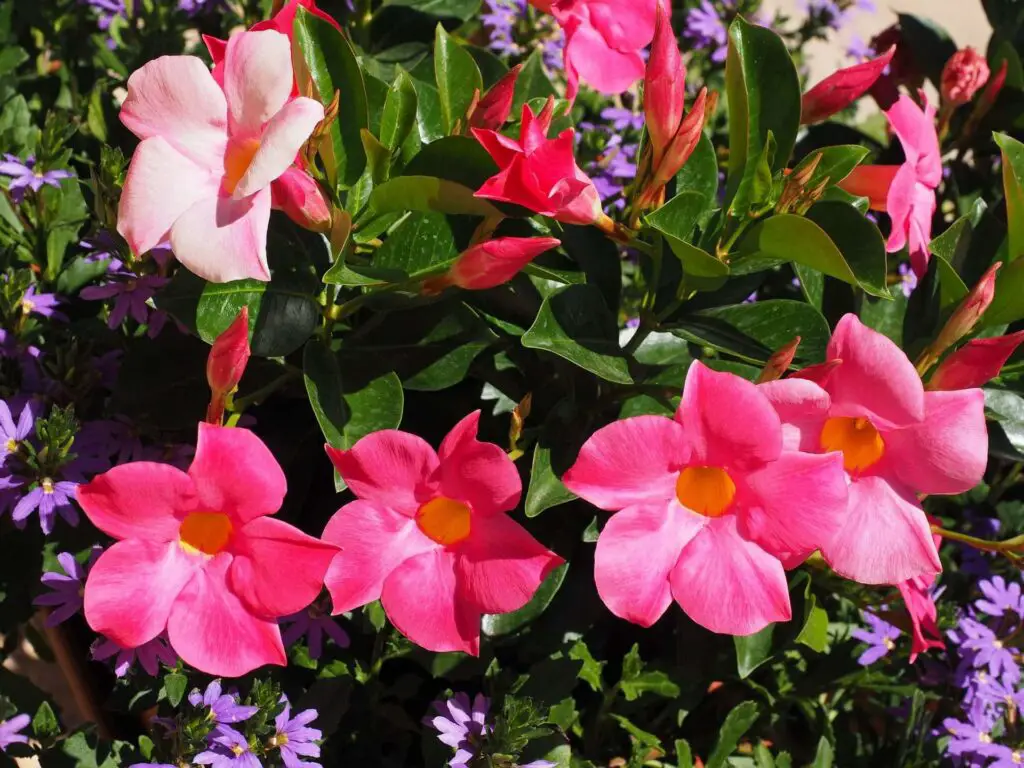Dipladenia is tropical plant native to south and Central America more specifically its origin backs to Brazil, Rocktrumpt is another common name for Dipledenia.
this plant is one of the favorites for most gardeners for outdoor planting, and it could be suitable for indoor garden too, it won its status in gardeners community due to its wonderful look and vibrant presence.

It belongs to dog bane family, and since we mentioned dog bane family it means that you should be careful when you have Dipladenia plant in your garden because all plant parts are toxic, so make sure to keep it away from children and pets reach.
Difference between Dipladenia and Mandevilla
Most people confuse Dipladenia with Mandevilla since the two plants look mostly alike, Both plants attract bees and hummingbirds and they require the same care and conditions to thrive. however, the only caring difference is Mandeville needs a supportive object to climb on. otherwise, the same care and tips apply to both plants.
Dipladenia and Mandevilla both belongs to Mandevilla genus, but the difference between the two plants lays on their different growth patterns, while Mandevilla tends to climb and vine and it can reach up to 20 m, Dipladenia tends to bush and lays down its stems.
Therefore if you are interested in plant that belongs to Mandevilla genus and you want it to climb trills, arches, arbors or lampposts go for Mandevilla, in the other hand if you want to enjoy the same genus in hanging baskets or bush shape go for Dipladenia.

Dipladenia and Mandevilla care
While having Dipladenia in your garden gives you plant that is magnificently good looking and Variety of flowers colors that bloom more than five months during the year, it also needs special care and efforts, Don’t worry I got your back read the following guide and you are good to go with your plant.
Choose the right location for Dipladenia
When choosing a site for Dipladenia keep in mind location that protected from rain and drafts, it requires warm climate, proper air circulation and it can tolerate been planted with other flowering plants in the same container as long as you gave each plant reasonable space in the container.
The spot should allow Dipladenia to get bright sunlight, although it tolerates direct sunlight and especially morning light which encourages the blooming.
The direct sun light applies for all seasons except summer as summer direct sun light exposure might burn your plant, during summer move your Dipladenia to shady spot if you planted in pot, in case its ground plant build sun shield to form shade during the sunny hours.
Giving Dipladenia the right Soil and container
I recommend to plant Dipladenia in removable container for two reasons, first to move it indoors when the climate is too cold and frosty as this tropical plant do not tolerate frost and any temperature below 45 degrees Fahrenheit, second to move the pot to shady spot when the direct sun is too hot during the summer which can burn Dipladenia leaves.
choose pot that have good drainage holes as this plant needs moist soil but not wet, also its important to use soil that is loose and humus.
The pot size is important don’t use relatively big pot as this may affect the blooms since the plant energy will be directed toward forming and expanding the root system instead of focusing its energy into blooming.
repot the plant every two years to overcome roots crowding use
watering
Even though Dipladenia is one of most blooms-rich plants, yet it is not water greedy, it demands moderate watering schedule, something close to every 9 days watering schedule is fairly efficient, however in summer it should be watered more frequently, Dipladenia do not tolerate excess watering and waterlogged soil.
Allow the soil surface to dray between each watering at same time keep the soil humid by frequent spraying, also when you water Dipladenia do it slowly to allow the soil to absorb the humidity.
Pruning
Dipladenia is one of the most cutting tolerant plants. actually, it likes it a lot, prune your plant at least once a year, ignoring proper cutting will delay the blooming with fewer flowers while cutting it back will encourage its new growth, flowering intensity and make it bushier.
The right pruning time is late winter or early spring, before it starts to form new shoots, the right timing is essential, you don’t want to cut the new growth which is the base of the summer blooms, wear gloves and use well-sharpen sterilized pruner and cut back old stems drastically, that’s only will lead to more new shoots, more blooms in the summer season, and bushier Dipladenia.
Fertilization
Generally speaking, due to Dipladenia intense blooming both in flowering intensity and its long blooming season; by its
During the growth period fertilize it once every 15 days by using half strength of 10-20-10 soluble fertilizer, mix it with water, and pour the fertilized water in the soil without it touching the plant foliage to avoid fertilizer burn.
When Dipladenia enters dormant or resting period during the winter stop the fertilizer completely, and resume your fertilization schedule at spring when new growth starts to emerge.
Overwintering
Since Dipladenia is tropical plant it will not survive in winter when temperature drops below 45 Fahrenheit degree in this case for best overwintering practice; bring your plant indoor either it is potted or ground plant.
Give Dipladenia bath before you transfer it indoor by sharp water hose to throw away any pests that may hide in foliage. Keep it indoors in a spot that sheltered from cold drafts and receives direct bright sunlight as much as possible; since lack of enough light may make it vulnerable to pests and diseases.
Water your plant in winter only when it needs it, as Dipladenia in general, do not tolerate over watering and wet soil, moist soil is fairly enough, you can tell if your plant needs water by checking the top two inches near its base, if you found it moist; it does not need water.
On the other flip of the coin, indoor heating system may cause the indoor climate to be drier and despite the fact that Dipladenia to reasonable degree is drought tolerant; don’t neglect the enough watering during winter.
In winter season Dipladenia enters its rest and dormant period; therefore don’t fertilize it during the whole winter. And it is normal if its foliage starts to dry out, it will grow new foliage and shoots in spring.Once the winter is over and the outdoor night temperature above 45 Fahrenheit degree you can move it outdoor.
Is Dipladenia Perennial or Annual?
Dipladenia grows as a perennial plant in its native area, and in areas that have frost-free climate (USDA of zones 9 to 11) since it can survive winter by killing itself and grows back in spring.
But in areas of USDA zones 8 and below; when night temperature in winter drops below 45 Fahrenheit degree Dipladenia grows as annual plant, unless you overwintered by moving it indoor.
